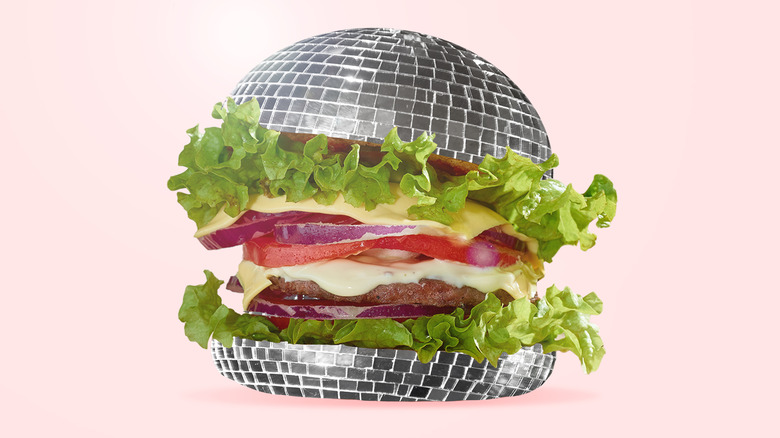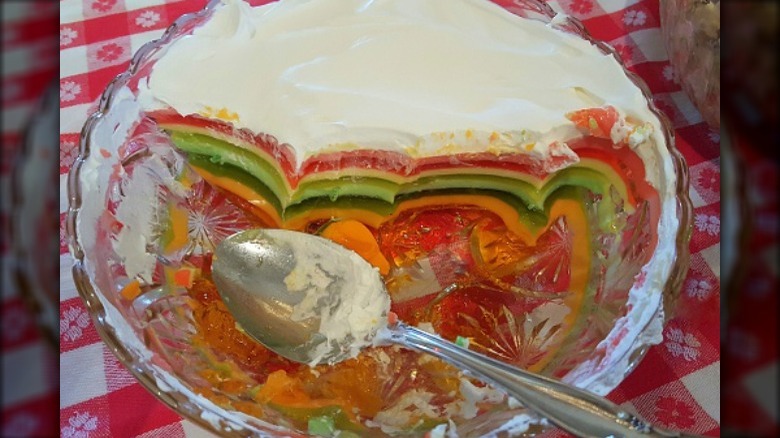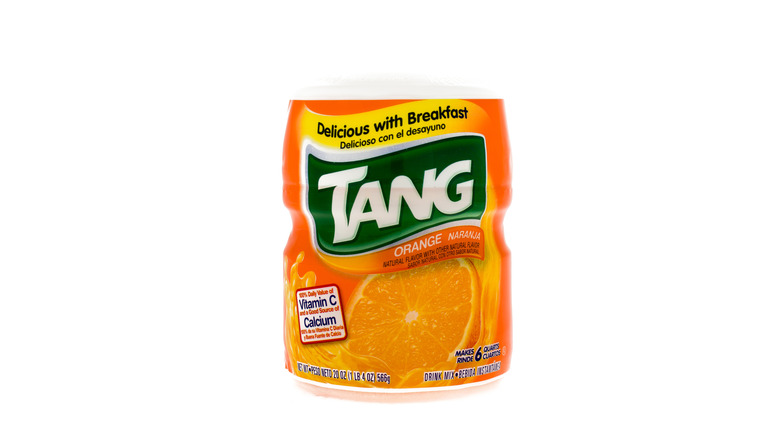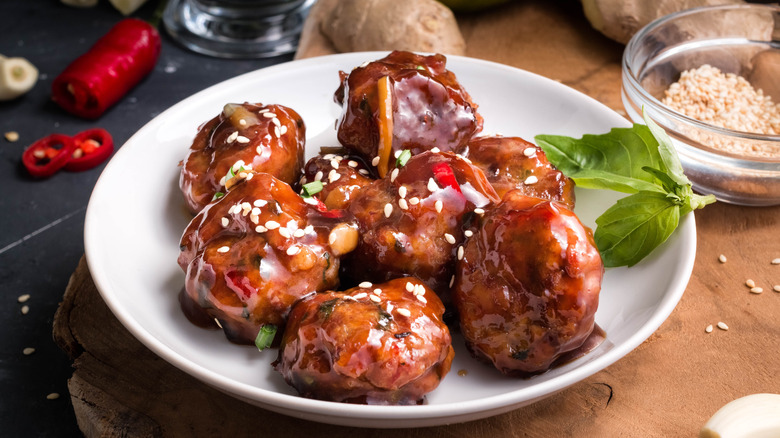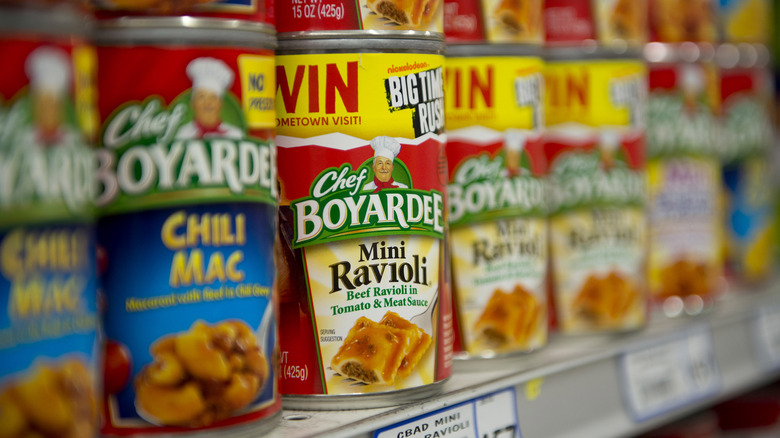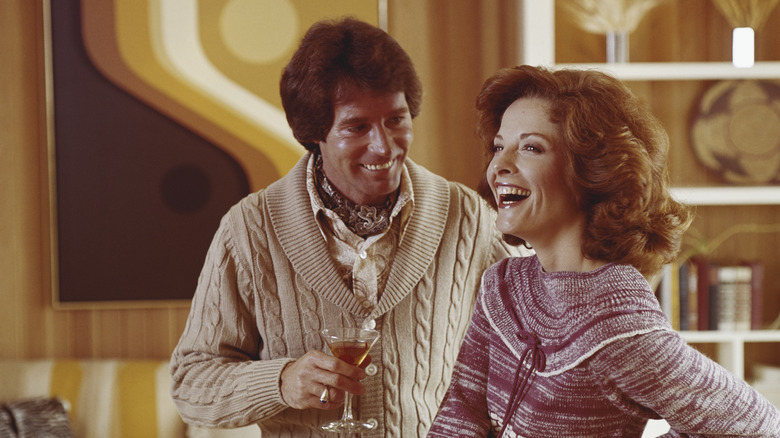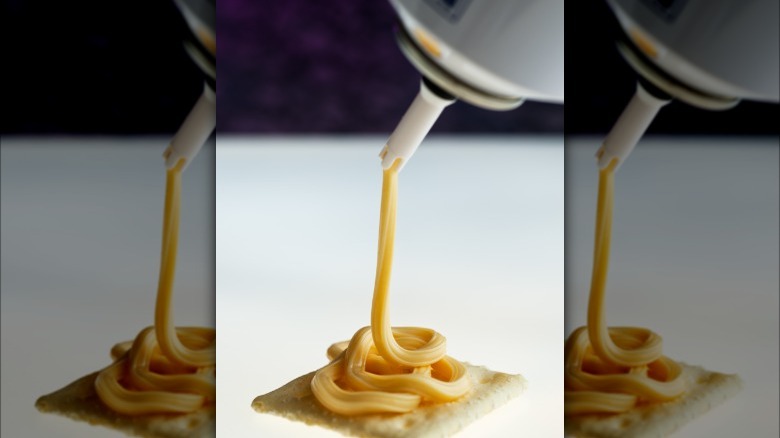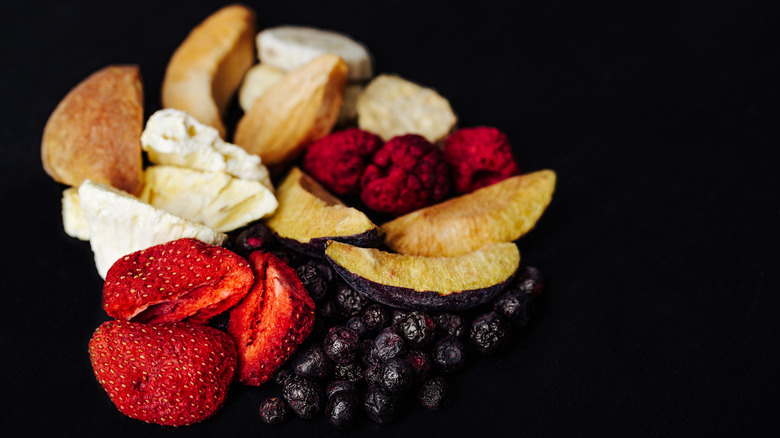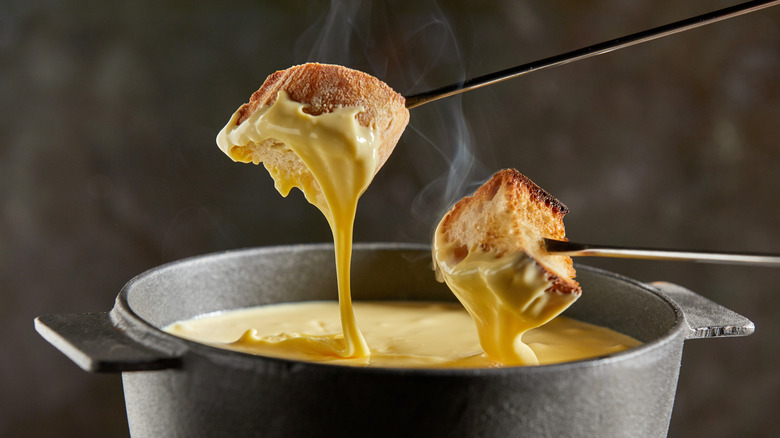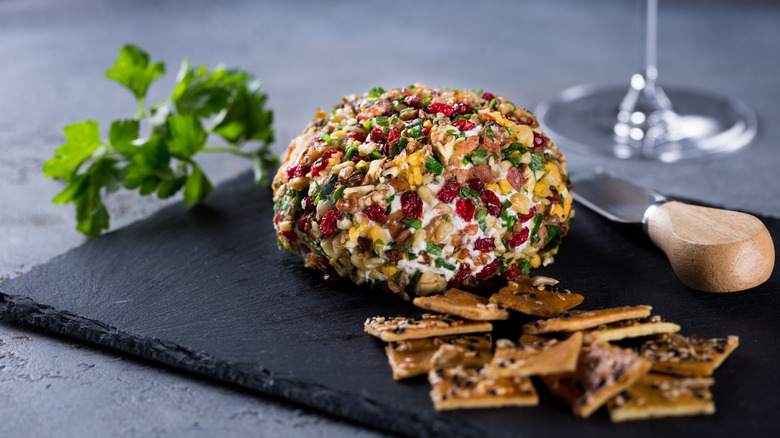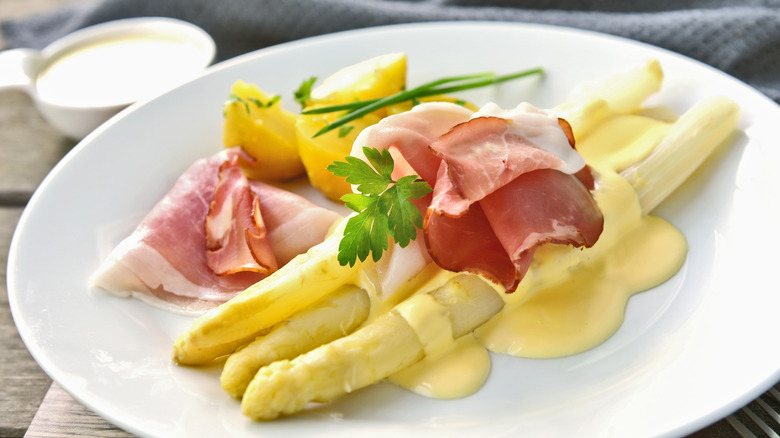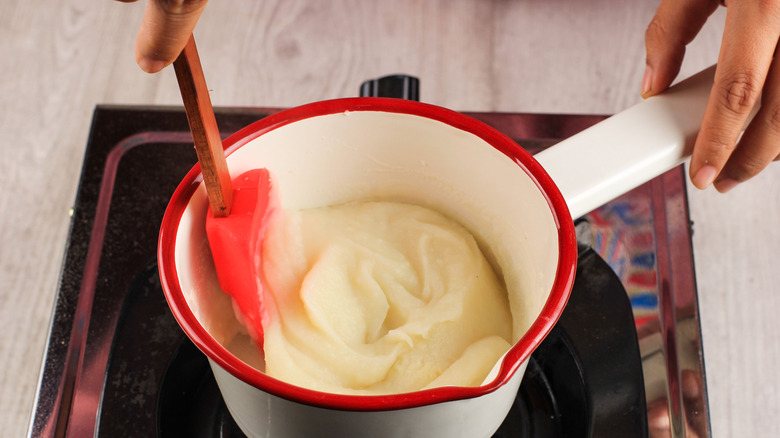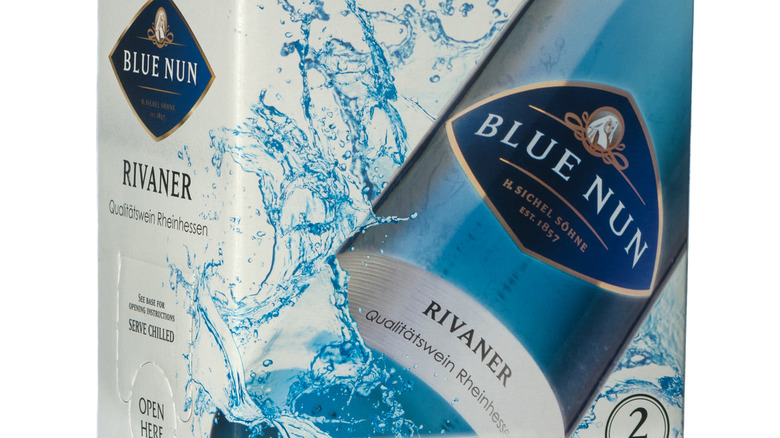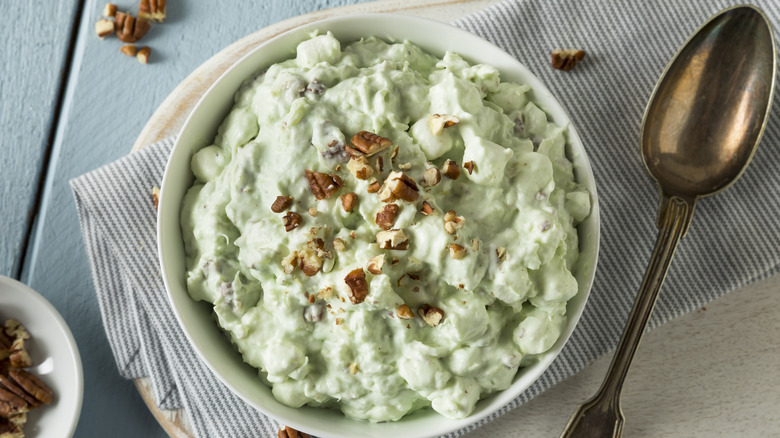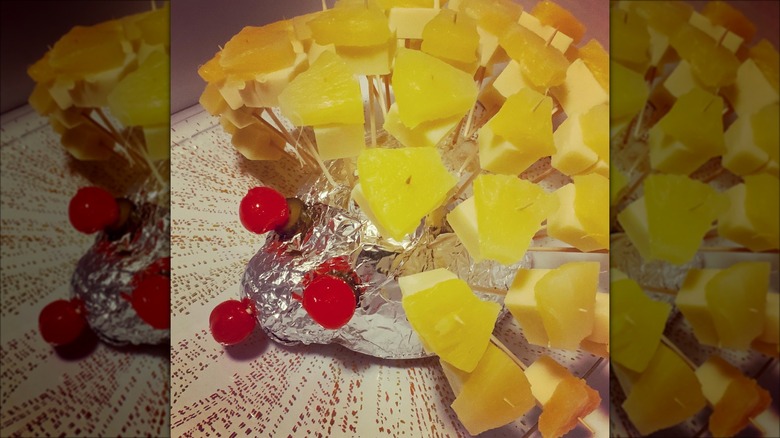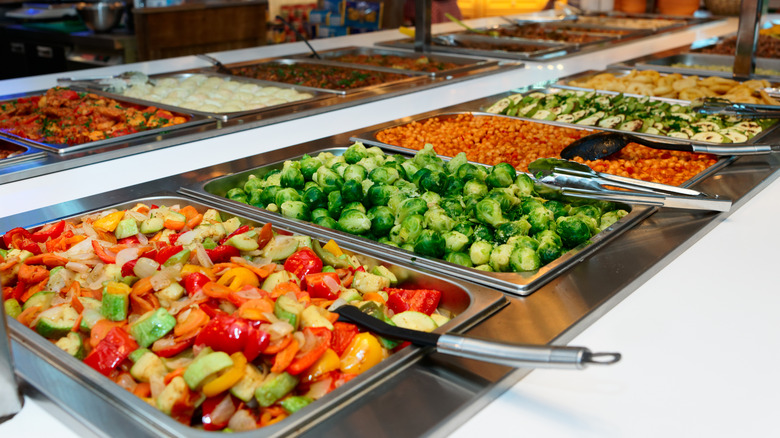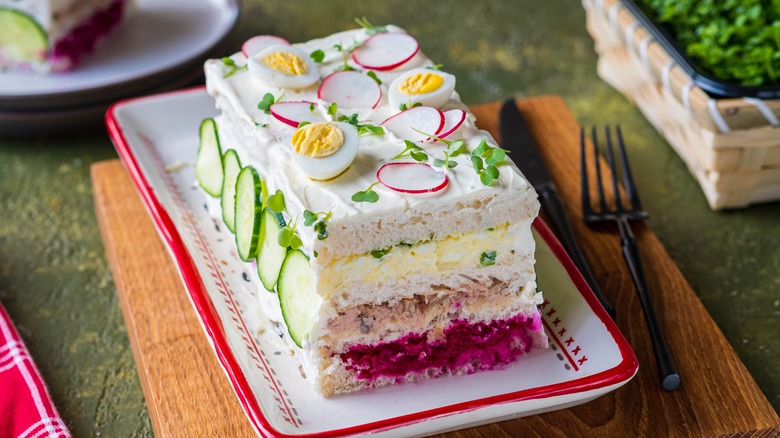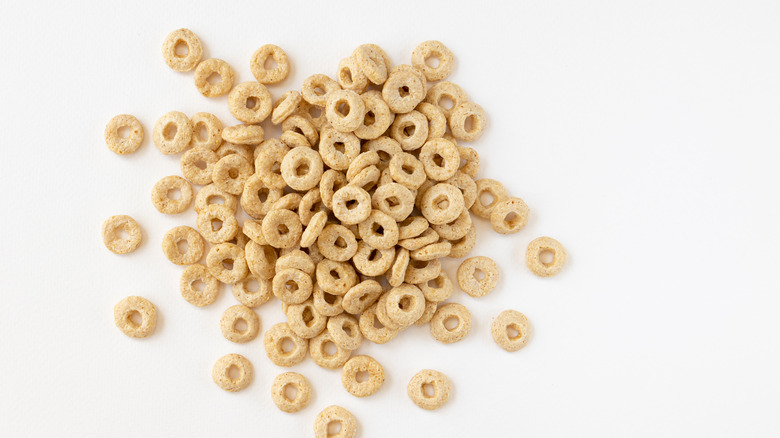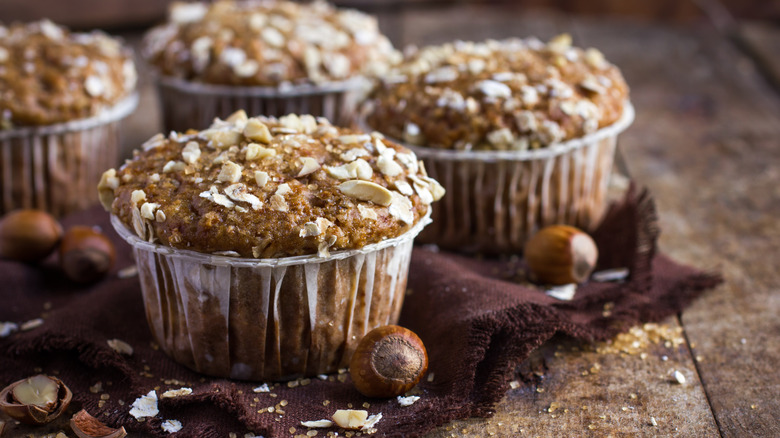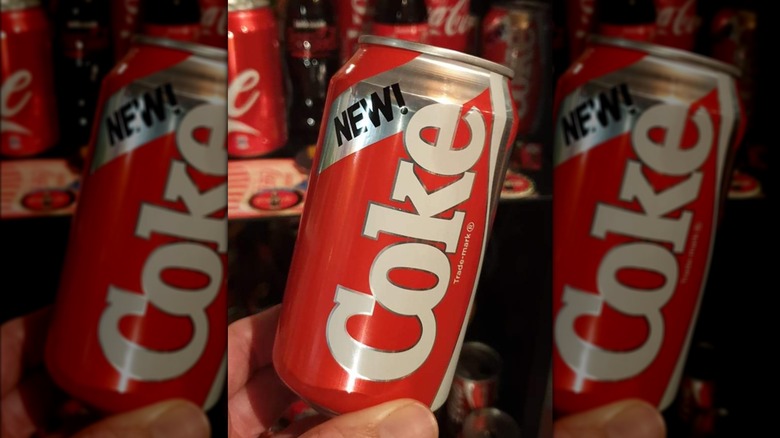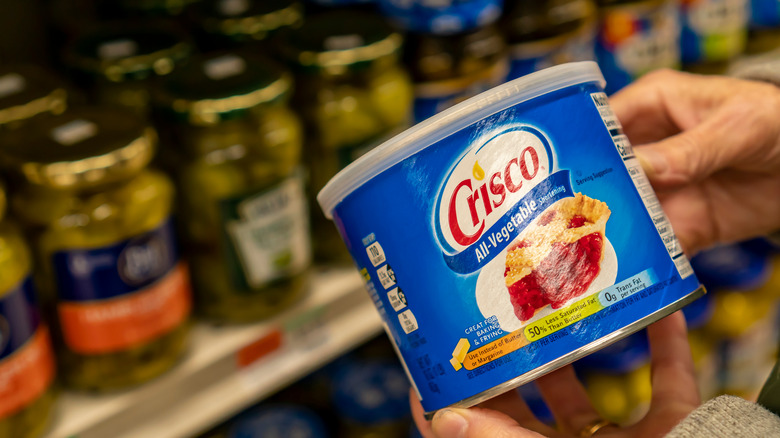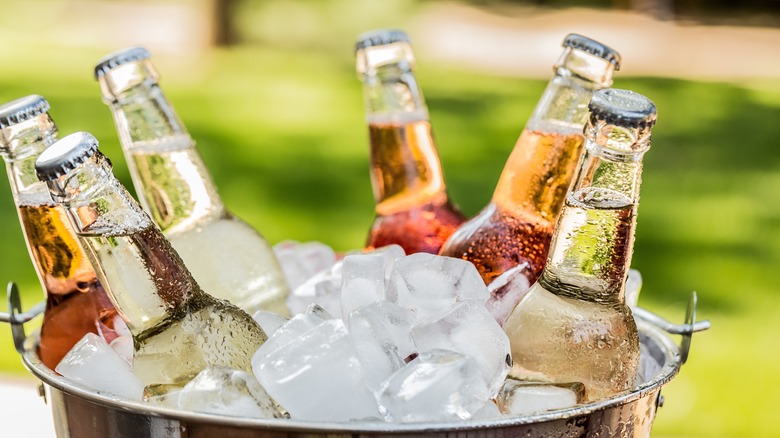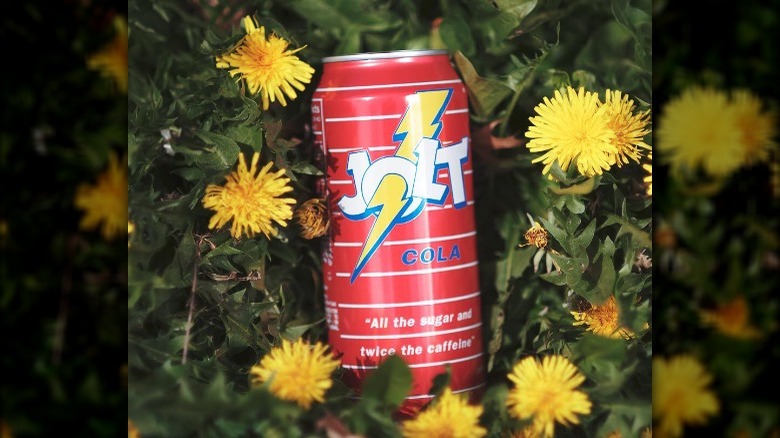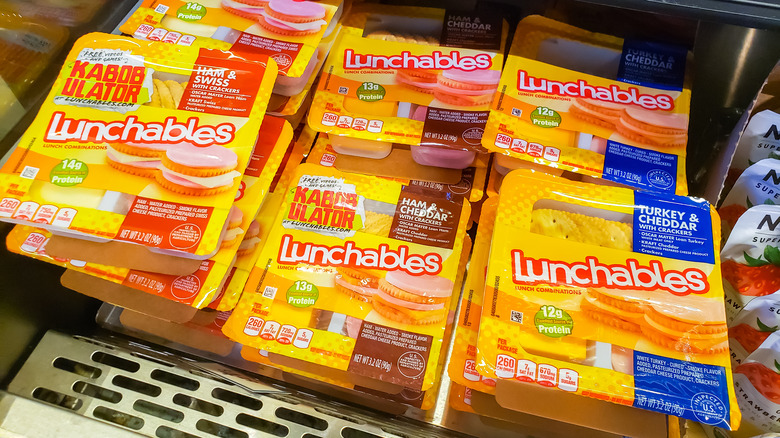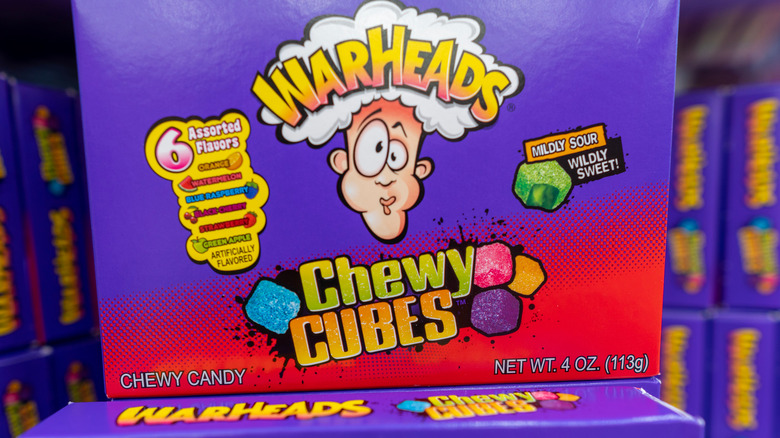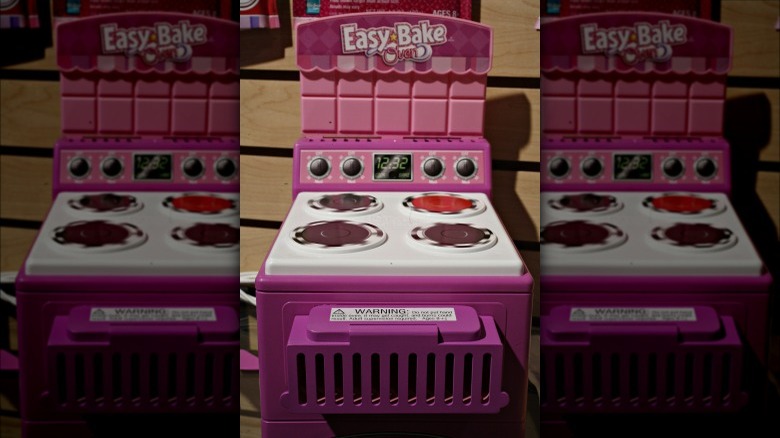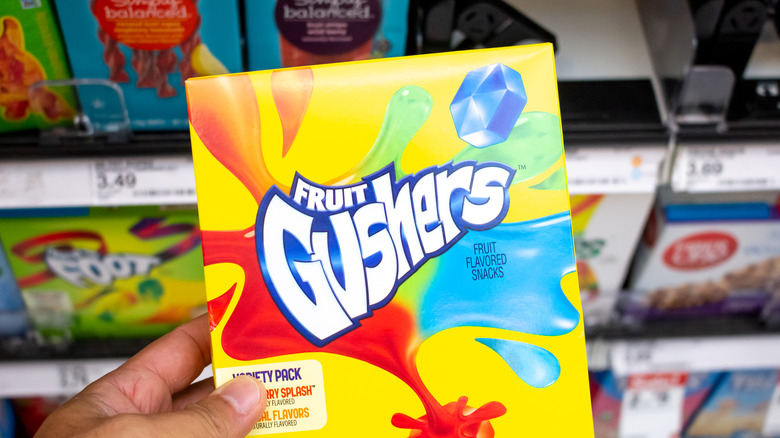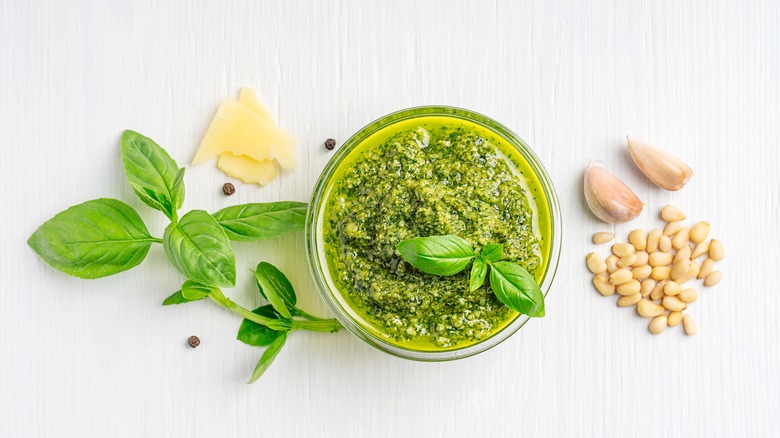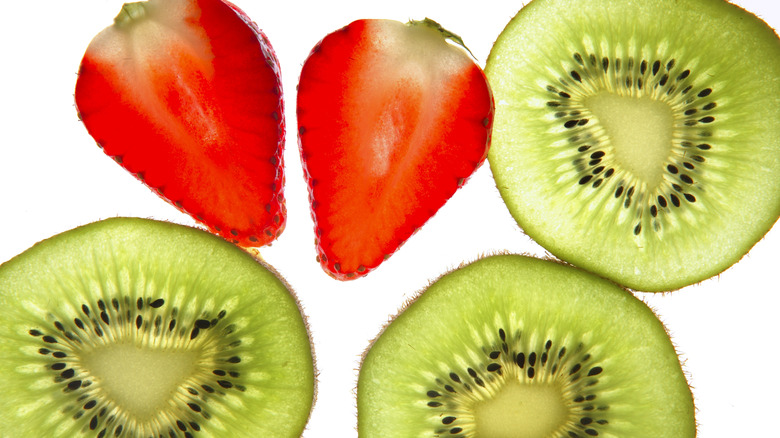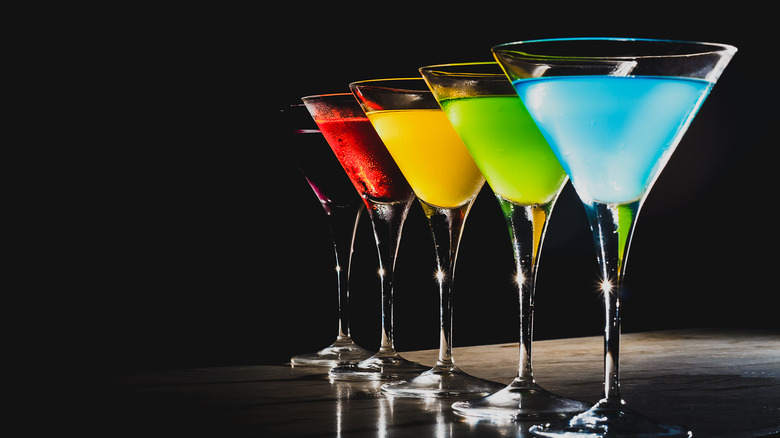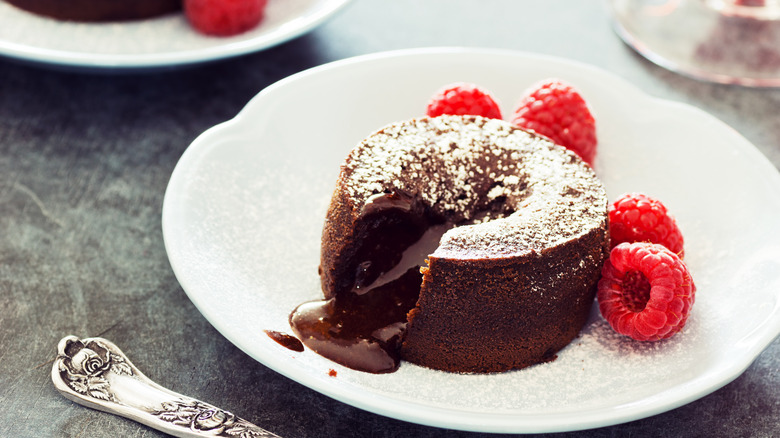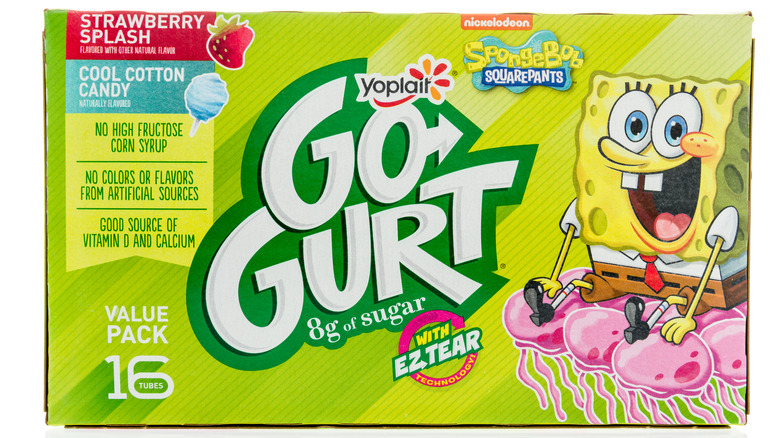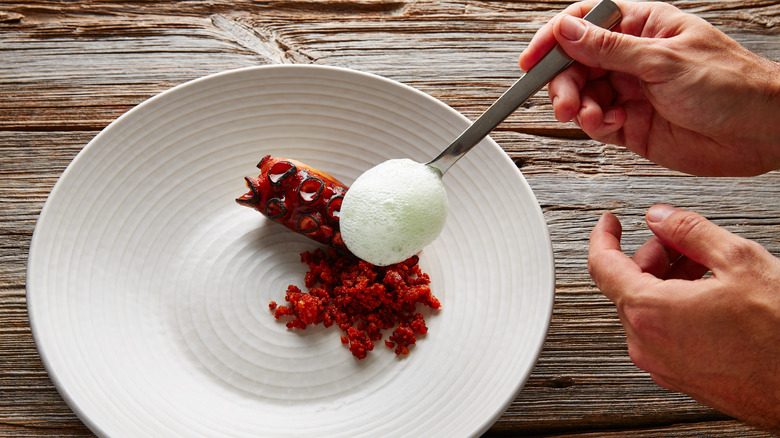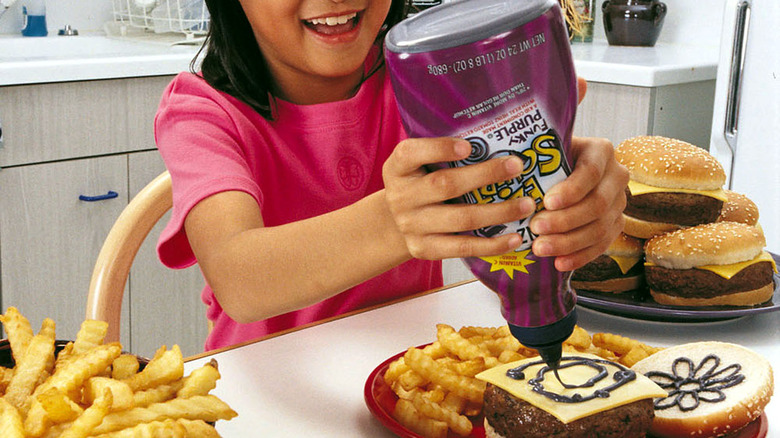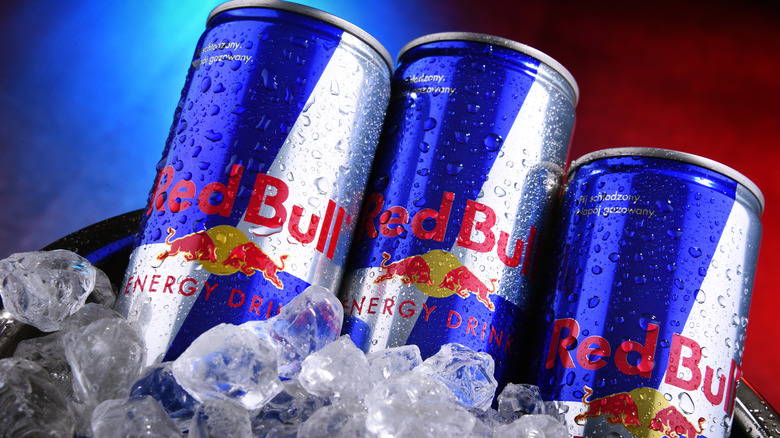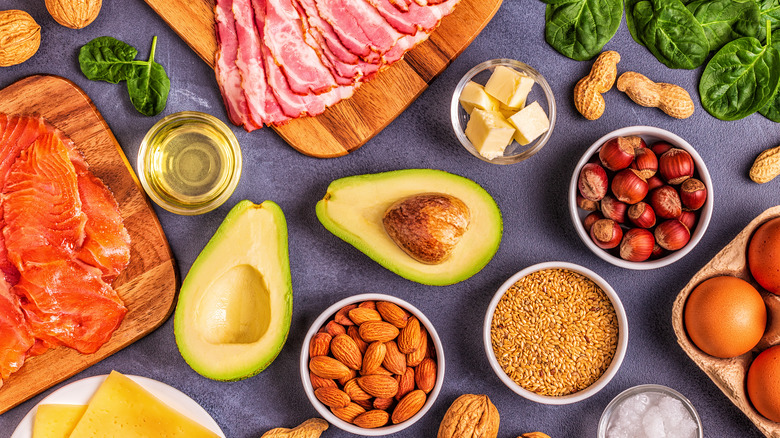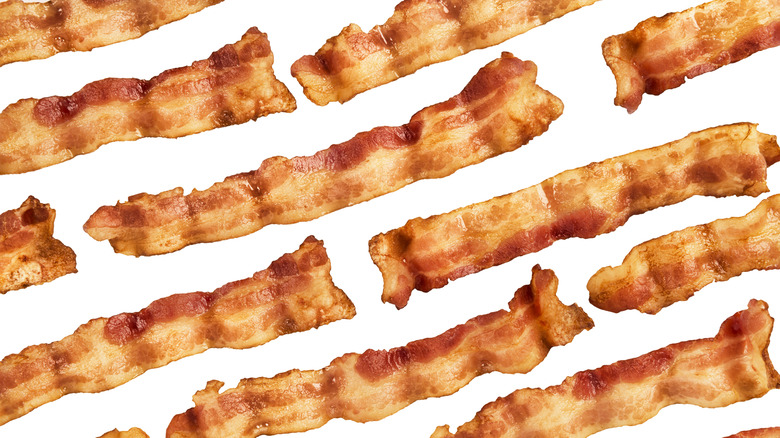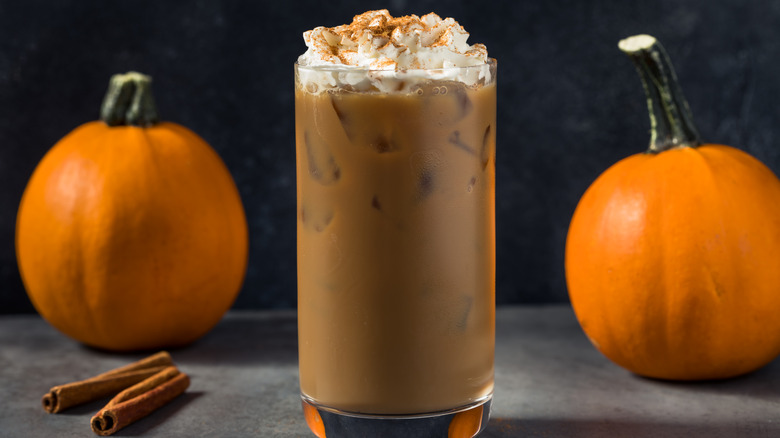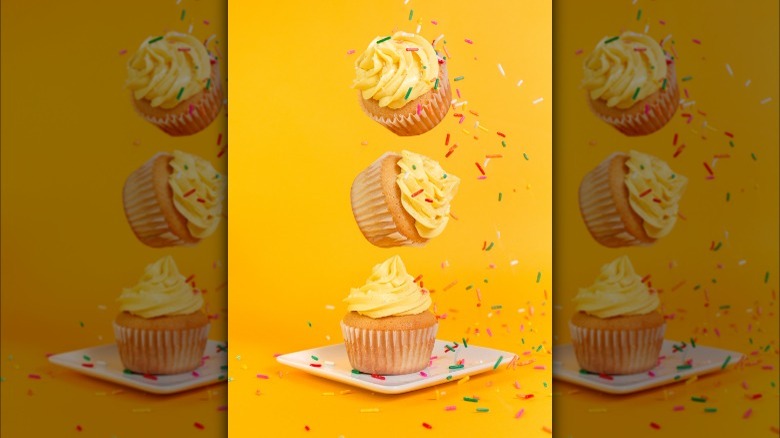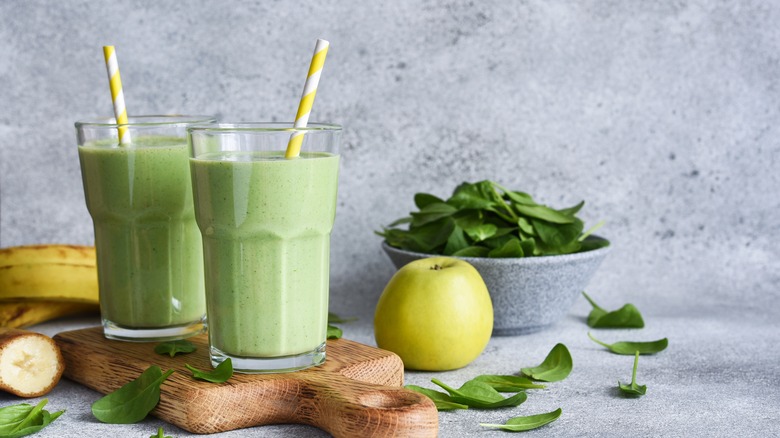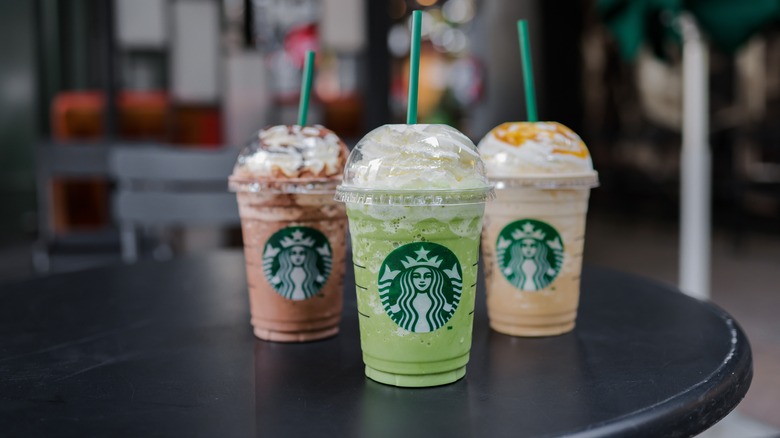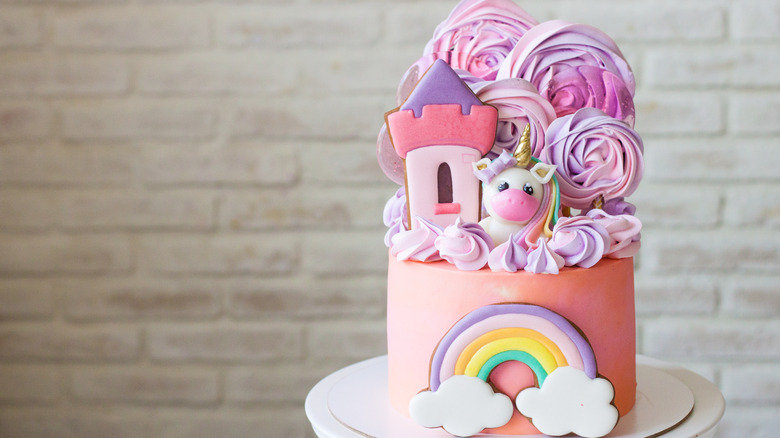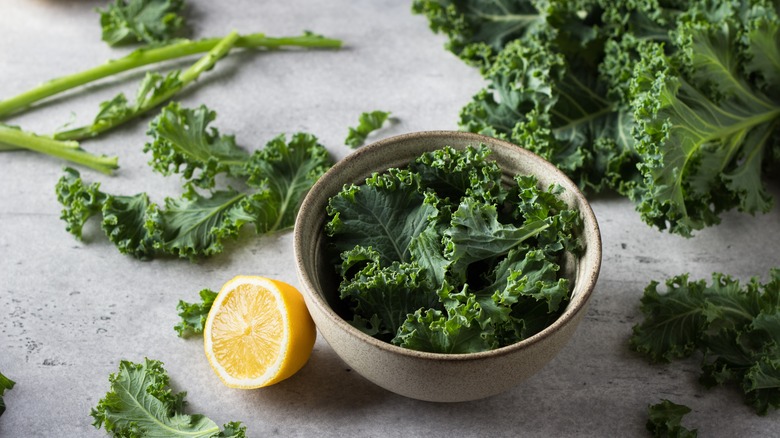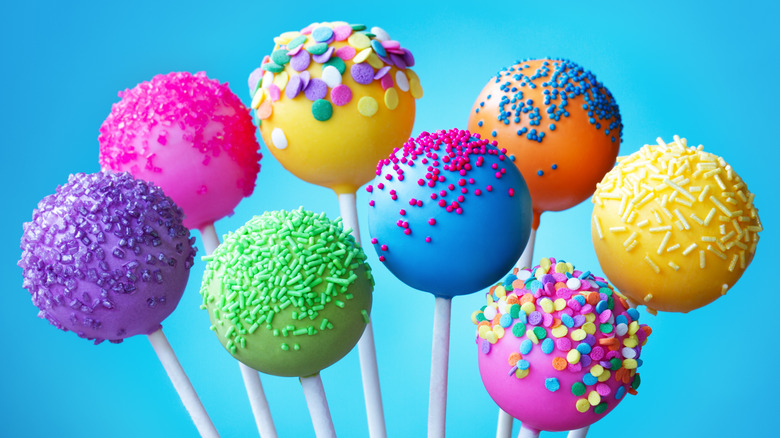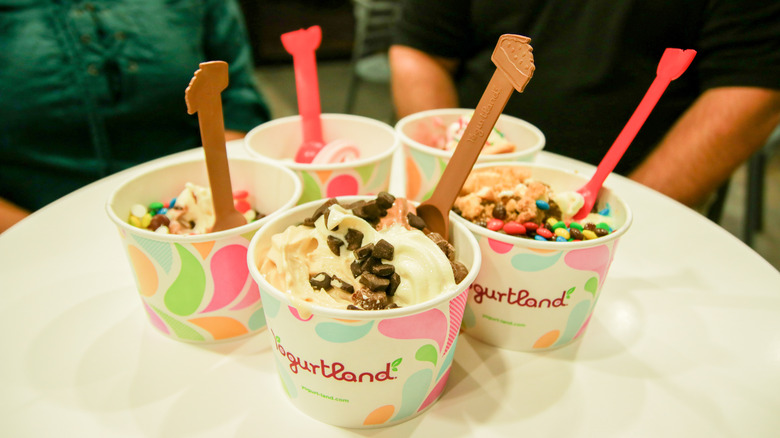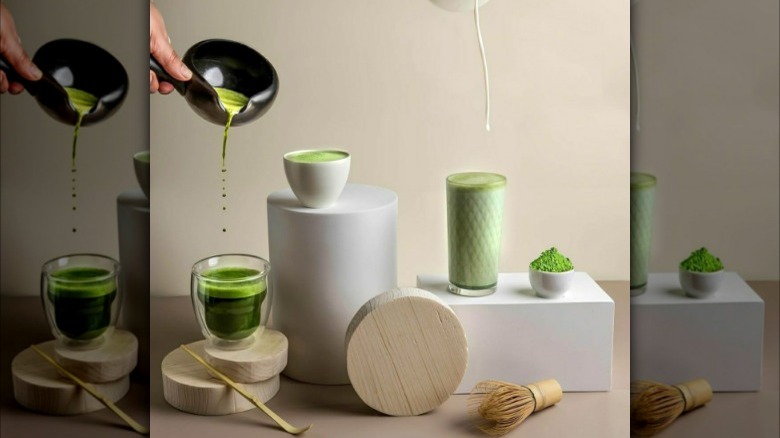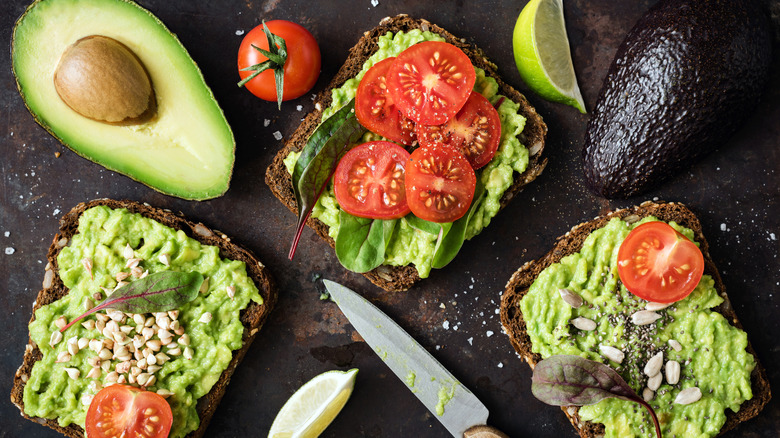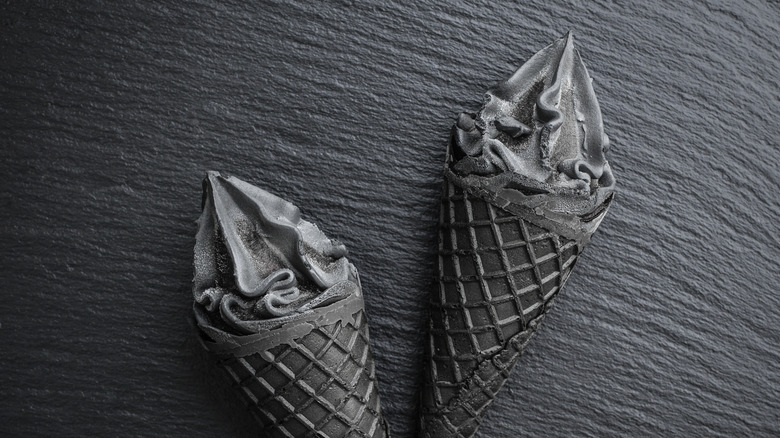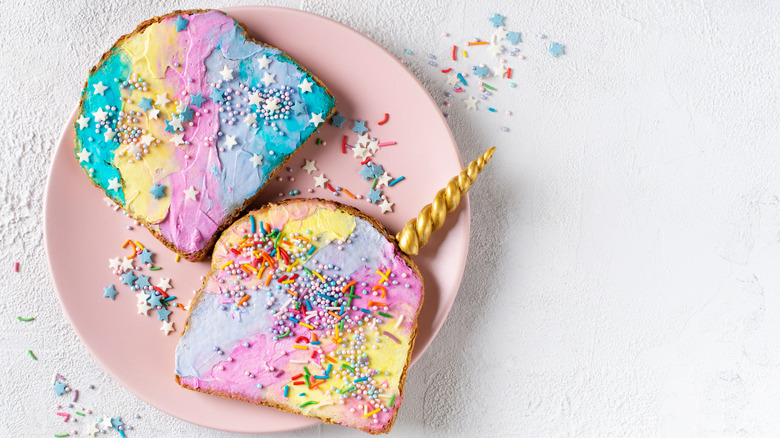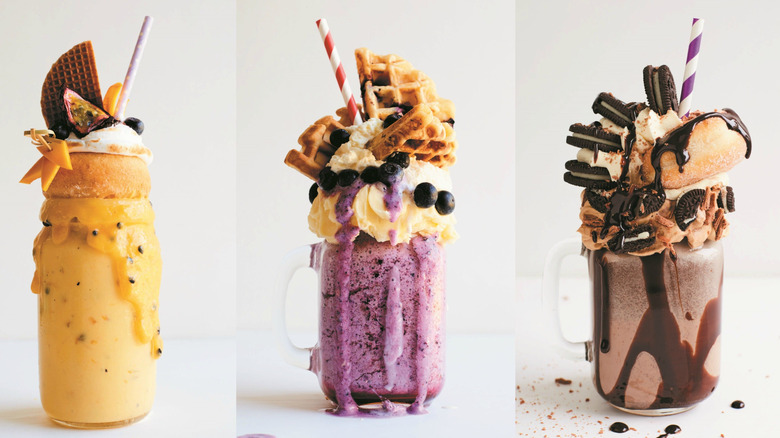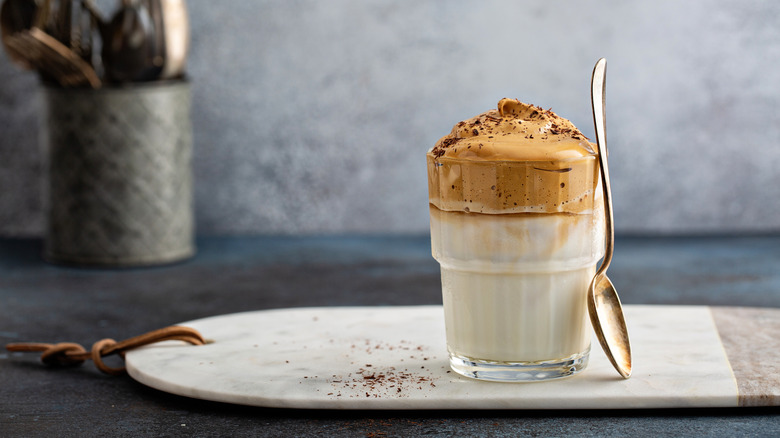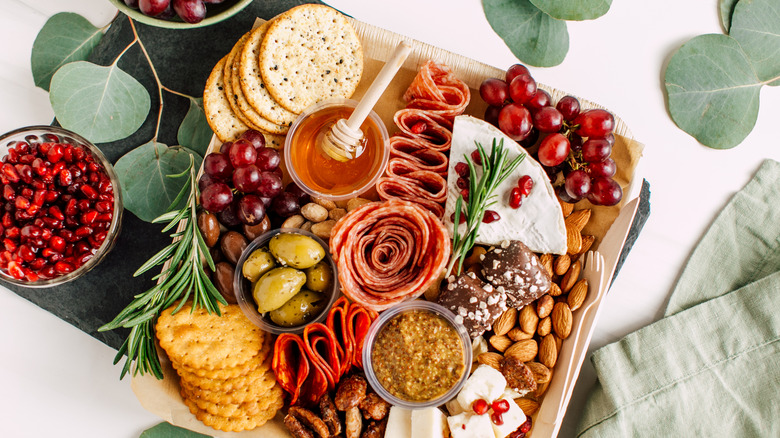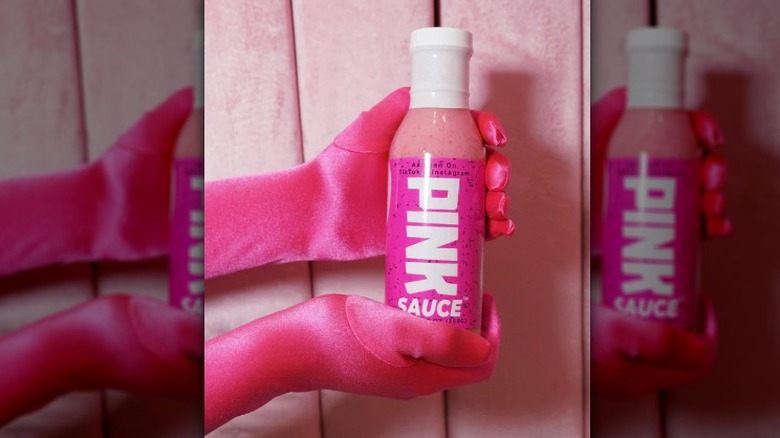The Most Ridiculous Food Trend The Year You Were Born
Each generation gravitates toward different foods in trends that ebb and flow. Food goes in and out of style as much as clothes or other cultural fads. Think about it — there's probably one dish or snack item that immediately conjures up memories of your childhood, regardless of when you were born. Trends aside, food can bring us back to a particular moment in time, especially for those of us who are known for keeping up with the most recent trends.
Looking at the past few decades, it's clear that the kind of food and drink that the mainstream culture indulges in has transformed tremendously. Some of those old-school recipes have fallen by the wayside, including those ultra-trendy food fads that didn't make it past their 15 seconds of fame, while others may yet enjoy a resurgence. We've broken down the most ridiculous food trends from the years all the way back to 1960, so you can figure out which wacky plate best connects to the year in which you were born.
1960-1961: Jell-O salad
At the beginning of the 20th century, the popular gelatin brand saw the creative salads its customers were making at home and released some truly ridiculous savory flavors that included celery, seasoned tomato, and Italian salad. Starting in the 1950s, people started mixing fruity Jell-O flavors with seemingly everything else, including meat, vegetables, and seafood.
Yet Jell-O salads reached a new height at the start of the 1960s. Back then, people came up with elaborate Jell-O creations that would have diners questioning whether they were looking at an edible plate or a work of abstract art.
1962 - 1963: Tang
Children of the 1960s will be instantly transported back to their youth at the mention of space-age Tang. The powdered orange drink was invented in 1957, but its popularity didn't take off (literally) until John Glenn brought the drink mix on the Friendship 7 spacecraft during his February 1962 orbit of Earth.
The drink wasn't just a novelty, though; it also helped improve the taste of water in space, which was affected by purification chemicals. The orange drink might not be as tasty or nutrient-packed as some modern-day products, but Tang will always elicit childhood memories for those who grew up drinking it.
1964: Grape jelly meatballs
Appetizers like meatballs on a toothpick aren't that ridiculous of a concept, but what about adding grape jelly to the mix? The unconventional recipe, called chafing dish meatballs in the 1960 cookbook "Elegant but Easy: A Cookbook for Hostesses," features raw meatballs simmered in a sauce made of grape jelly and tomato-based chili sauce. The recipe has evolved over time to use pre-cooked meatballs that are assembled with other ingredients in a slow cooker, but the roots were undoubtedly planted in the mid-1960s during the height of cocktail meatball fame.
1965: Canned pasta
Anyone who's enjoyed SpaghettiOs as a kid is more than familiar with Chef Boyardee cans, which were a part of World War II soldiers' rations. The brand was sold to a major food distributing company after the war.
Though it's decades later, 1965 remains notable as it saw the debut of SpaghettiOs. The concept proved so popular in the early stages of testing that the brand skipped ahead and began distributing cans nationally in October 1965. It was also the year the iconic "Uh-Oh, SpaghettiOs" slogan came out, meaning that ready-to-eat canned noodles truly marked the middle of the decade.
1966: Drinking Man's Diet
The Drinking Man's Diet all began in 1964 when Robert Cameron started selling a pamphlet of the same name for $1, touting a diet that allowed participants to both drink and lose weight.
Cameron's theory is rooted in the idea that liquors like whiskey or gin have trace amounts of carbohydrates. Hypothetically, a person can have as much meat and seafood alongside a stiff drink as they want in a day and still lose weight. The boozy diet is far from healthy or safe, but it sure was popular. "The Drinking Man's Diet" sold more than 2.4 million copies in 13 languages just two years after its release.
1967: Easy Cheese
After its 1966 debut, Easy Cheese forever changed the way we think of cheese and crackers. In its early years, the brand tried to tell everyone that Easy Cheese can go on everything from vegetables to hard-boiled eggs. There were even recipes for cocktail party appetizers using spray cheese, which was supposed to be somewhat gourmet at the time. For those with a particular taste for spray cheese, Easy Cheese branding even claimed that the stuff was good on fresh fruit. Now that's an adventurous palate.
1968-1969: Freeze-dried food
Freeze-dried food has been key for backpackers for decades, but the height of freeze-dried food's popularity undoubtedly came during the Space Race of the 1960s.
NASA even helped advance freeze-drying technology. However, popular as astronaut ice cream may be in gift shops, it only ever made it to space during the 1968 Apollo 7 mission. It turns out freeze-dried ice cream isn't appetizing or practical, making it a better novelty item than a must-have for space travel.
1970-1971: Fondue
The 1970s would be nothing without fondue, with chic parties that brought people together over gooey cheese. There's nothing overly complicated about melting down cheese and dipping food in it. The act makes it special, as it incites conversation and connection among those gathered around the pot.
Fondue was part of exhibits sponsored by Swiss industries during the 1964 World's Fair in New York. A dish that started as a simple way to use up stale bread ended up marking the 1970s almost as much as disco or feathered hair.
1972: Cheese balls
The 1970s were cheesy in more ways than one, which is perhaps why cheese balls were also popular appetizers of the decade, especially during the holiday season.
Recipes vary, but the standard base is cream cheese that's then combined with other kinds of cheese and spices into a ball, then coated with herbs, nuts, seeds, fruit, and more. It's the perfect combination of creamy and crunchy, especially when served alongside crackers or fresh vegetables. Cheese balls come in and out of style every few decades, but the 1970s were definitely its heyday.
1973: Ham and banana hollandaise
The U.S. bicentennial celebrations of the mid-1970s resulted in quite a few unique recipes, such as ham and banana hollandaise from McCall's Great American Recipe Card Collection. The name doesn't leave much up for interpretation, which might be a bad thing. The recipe features baked bananas topped with mustard and ham and drenched in hollandaise sauce. We're not exactly sure whose palate this is supposed to satisfy, but you'd be hard-pressed to find a modern-day rendition of this dish in a fancy restaurant.
1974: Smash instant mashed potatoes
These days, "instant potatoes" is a bad word among foodies, given that this product doesn't live up to the real thing in flavor or texture. But in the early 1970s, Smash-brand instant potatoes were a popular and convenient dinner staple.
Smash is fondly remembered for its intergalactic ads that featured robots and aliens. Most kids from the 1970s likely have the Smash ads burned deep into their brains, even if the potatoes themselves weren't noteworthy.
1975: Blue Nun wine
Blue Nun wine might not be recognizable to anyone born after the 1990s, but it was once the white wine of rock stars. The German wine was created in the 1920s, but it peaked in the 1980s when it sold millions of cases annually.
The white wine was sweet, inexpensive, and low in alcohol, making it palatable to novice wine drinkers. The smirking nun on the label and blue bottle made it all the more recognizable. Blue Nun is ridiculous for its novelty but may be remembered fondly by those who used to order it as their drink of choice.
1976: Watergate salad
Watergate Salad is one of the most nontraditional salads of all, combining pistachio pudding mix, canned pineapple, marshmallows, whipped cream, and chopped nuts.
As you might expect, the salad gets its name from the infamous Watergate scandal. It was preceded by a pistachio cake named after Watergate, too. We assume its name may have been a way for people to make light of a dark situation. Watergate salad isn't exactly appetizing to behold, which probably contributed to its decline.
1977-1978: Cheese and pineapple hedgehogs
Cheese and pineapple hedgehogs were a 1970s phenomenon in the United Kingdom in particular. It starts with a base shaped like a hedgehog body, like a slice of watermelon wrapped in foil. Then, you cover the foil with toothpicks that each have one piece of cheese and pineapple. Two maraschino cherry eyes put the icing on the cake of this wacky party dessert that may not be practical but certainly was a conversation piece in the 1970s.
1979-1980: Salad bars
The phenomenon of salad bars seems to be the only way to transition from the 1970s to the 1980s. In the new decade, salad bars were popping up in restaurants, grocery stores, and beyond with seemingly more topping options than ever, both hot and cold. Wendy's launched a salad bar concept in 1979 and Burger King shortly followed. The idea forever revolutionized meal prep and going out to lunch, but it is a bit ridiculous how salad bars popped up everywhere through the 1980s.
1981: Holiday sandwich loaves
If you thought party food in the 1970s was weird, just look at the holiday party sandwich loaves of the 1980s. The concept of this dish was to make a sandwich that resembled a cake and which could feed a crowd, since that's such a necessity.
The inside consisted of layers of white bread with various fillings, usually something of-the-time like ham, egg, or olive salad. Then, the entire loaf was "frosted" with cream cheese, cottage cheese, or mayonnaise. The loaf was sliced like cake, which proved visually impressive but not the most appetizing way to eat a sandwich.
1982: Hot buttered Cheerios
Snacks in the 1980s were a category all their own, like the phenomenon that is hot buttered cheerios. These are simply pan-toasted cheerios cooked in butter and salt. Plain Cheerios were a staple in this recipe, though we think Honey Nut Cheerios would provide more of a sweet and salty dichotomy.
An official 1982 ad promoted "Hot Buttered Os," so this wasn't just a word-of-mouth recipe. It's one of the few throwback foods you can easily still eat today and use as a base for creative variations with different Cheerios flavors.
1983-1984: Bran muffins
Every decade comes with its health fad, and the 1980s had people all-in on bran. The high-fiber grain was often eaten via bran muffins. Many public campaigns were touting the ability of oat bran to help lower cholesterol and increase life expectancy. We know that you can't totally transform your health by adding just one food into your diet, but bran muffins are still just as healthy all these years later.
1985: New Coke
We'd be remiss not to mention the 1985 release of New Coke. Often called one of the biggest marketing mistakes of all time, Coca-Cola tried to fix something that wasn't broken by reformulating its flagship soda. The change resulted in protests, people hoarding cases of "old" Coke, and thousands of angry phone calls to brand headquarters. The company quickly started selling the classic formula again. New Coke will forever be remembered as a soft drink trend that never really had a chance.
1986: Cooking with Crisco
Crisco is still available, but in the 1980s it completely transformed home cooking. The original Crisco formula was full of trans fat, meaning it fell out of popularity when people learned about the negative impacts of the dietary fat.
At the time, those health effects weren't known. In 1986, Burger King was praised for cooking with supposedly healthy partially-hydrogenated oils. With the neutral taste and long shelf life of Crisco, the average 1980s cook had plenty of reason to swap butter or lard for this seemingly magic ingredient.
1987: Wine coolers
Wine coolers are often the first alcoholic drink many people try. In the late 1980s, the colorful bottles were all the rage. Wine coolers were invented at the beginning of the decade and saw more than a billion dollars in sales in 1987.
Usually, old-school wine coolers featured white wine and fruity, cheap soda with plenty of bubbles. It was the early rendition of the ready-to-drink canned cocktail options we have today, so the fad must be honored.
1988: Jolt Cola
Jolt Cola was the soda for thrill seekers as it contained real sugar and twice the caffeine of a regular soft drink. Since its 1986 release, it's become a cult favorite for rebellious people looking for a taste of what's bad for them.
Jolt was created in direct response to major soda companies that were busy debuting diet, caffeine-free, and sugar-free versions of their drinks. Jolt was popular enough that it made an appearance in 1990s films like "Wayne's World" and "Jurassic Park" before it fell by the wayside in the 2000s amidst the sea of high-caffeine energy drinks.
1989: Lunchables
First invented in 1988, Lunchables have been a major part of school lunches for decades. The convenience and novelty of kids assembling their own lunches was a major draw to customers, even though the brand initially meant to get more people to eat Oscar Mayer bologna after it fell out of favor.
More than $200 million of Lunchables were sold in its first year. Lunchables have reigned supreme ever since, especially after the beloved pizza version was introduced in the 1990s.
1990: Warheads
Warheads are more of a candy challenge than they are an indulgent treat. The sour candy, which was invented in Taiwan in 1975 but didn't make it to the U.S. until the 1990s, is not for those with picky palates thanks to a secret outer coating on every piece.
Warheads were the quintessential sour candy for friends who wanted to see who could stomach the most. The act of torturing yourself with extremely sour candy was a rite of passage for many 1990s babies, so it's the only right way to kick off the decade.
1991: Easy-Bake Oven
For many of us, the Easy-Bake Oven was the toy of our childhoods that gained attention because it could produce real food. Easy-Bake Ovens were invented in the 1960s, but the toy saw great success in the 1990s with the expansion of baking recipe sets created in partnership with major food brands.
Between 1993 and 1998, the brand sold more than 5 million ovens. In 1993, Easy-Bake Oven revamped its design to resemble a mini-microwave with even more recipe options in honor of the brand's 30th anniversary.
1992: Fruit Gushers
Nothing screams kids' food more like Fruit Gushers. The brand changed the fruit snacks game by filling their gummy treats with explosive liquid for a wacky eating experience after they debuted in the early 1990s. Many '90s kids will remember some of the wild ads that aired on channels like Nickelodeon featuring kids turning into living pieces of fruit after they bite into the candy. The allure of the snack might have been more enticing than the treat itself, making it an absurd part of some of our childhoods.
1993: Pesto
Anyone who lived in the 1990s will remember everyone's seemingly random obsession with pesto. Pesto isn't a ridiculous ingredient by itself, but the public's fascination with it in the early 1990s sure was. Italian-American food became seriously popular in this decade, marked by cookbooks like 1992's "Essentials Of Italian Cooking."
Non-Italian cooks were clearly fascinated by this nutty, basil-based sauce. While some home cooks and restaurant chefs made fresh pesto, the early 1990s also saw more jarred pesto varieties popping up on grocery store shelves, making it even easier for people to get their hands on the green stuff.
1994: Strawberry-kiwi flavor
Strawberry-kiwi is a common flavor combination for drinks or candy these days, but isn't it odd to think of how these two seemingly unrelated fruits came to pair up? Snapple introduced the public to the flavor in the early 1990s and everyone jumped on board — it was Snapple's most popular flavor in 1995. Strawberry-kiwi is perhaps not as popular as it was back then, but it's still around to remind us of the heady drink days of the '90s.
1995-1996: Flavored martinis
Cosmopolitans, appletinis, espresso martinis — the 1990s were all about mixing vodka with whatever, pouring it into a glass, and adding "-tini" to the name. Flavored martinis were all the rage at the time, and they've made a comeback recently.
The classic martini might be gin and vermouth with a twist, but 1990s drinkers loved vodka and anything it would mix with to make it look fancy. Other drinks of the moment were the somewhat forgotten Breakfast Martini or the raunchy Pornstar martini, both with enough booze to make you blush like the color of your drink.
1997: Chocolate lava cake
No dessert exemplifies 1990s fine dining more than chocolate lava cake. A lush, decadent lava cake is filled with a molten center that can burn your tongue if you don't give it a minute to cool. The dish found its footing in 1980s restaurants but had become truly inescapable just 10 years later.
It's common to see restaurants offer a version of chocolate lava cake, but the dish fell out of fashion in the 2000s with many of the fads from the previous decade.
1998: Go-Gurt
Squeezable yogurt in a tube could only be a brainchild of the 1990s, which is why the invention of Go-Gurt makes so much sense. It was geared toward kids who were clearly on the move and couldn't be bothered to stop and eat a snack with a spoon.
Go-Gurt became widely available in 1998. It was easily recognizable in the refrigerator aisle thanks to its bright green box adorned with various beloved cartoon characters of the time, including SpongeBob SquarePants.
1999: Foam
Culinary foam is a controversial subject, but there's no denying that its main goal is to get people talking about food. Chef Ferran Adrià wowed 1990s diners by incorporating savory culinary foams into his dishes. The trick took off in fine dining restaurants across the globe but became cliché by the end of the 2000s. Now, foam is still here and there on restaurant menus, but it never had another major moment as it did at the end of the 20th century.
2000: Colorful ketchup
Y2K kicked off with a bang thanks to Heinz totally butchering the humble condiment that is ketchup. In July 2000, the brand released its EZ Squirt ketchup, which came in unnatural colors like green and purple. It was a gimmicky attempt to reinvigorate ketchup, but visually, it was a bit unappetizing.
The green ketchup was the first to debut in a promotion for the animated film "Shrek." But the novelty wore off by 2006 when EZ Squirt was discontinued. Yet, for '90s kids, this condiment remains hard to forget.
2001: Energy drinks
Red Bull has been around since the 1980s, but it didn't make its U.S. debut until the late 1990s. In the 2000s, Red Bull became a popular mixer for clubbers who wanted a caffeine boost to fuel long nights. By 2001, Red Bull celebrated its billionth can sold — and it was just getting started.
The massive interest in energy drinks led to the creation of Monster energy drink in 2002. The beginning of the decade also saw the birth of the 5-Hour Energy shot. While experts have raised concerns about the health risks of too many energy drinks, it wasn't enough to stop determined partygoers and night owls who ran on the stuff.
2002: Low-carb diets
In the early 2000s, it felt like everyone was on a low-carb diet. The Atkins Diet, which promotes eating little-to-no carbs and plenty of protein and fat, has been around since the 1960s. However, the diet culture of the early 2000s led to renewed interest in low-carb diets meant to help people lose weight quickly while still being able to consume cheese, meat, and butter.
The South Beach Diet, which also promotes restricting carbs, came about in 2003, though the low-carb trend was already in full force among fad dieters. In more recent years, low-carb eating has come back in the form of keto diets, though this trend may not be as popular as they were in the first years of the 2000s.
2003: Bacon
There was a period in the early 2000s when bacon seemed to appear in and on everything. The cookbook "Everything Tastes Better With Bacon" was released in 2002 while, in 2003, retail bacon sales reached more than $2 billion, proving that we just couldn't get enough of the stuff.
It wasn't just bacon on pizza and burgers — we put it on donuts, in milkshakes, and even ate it drenched in chocolate. The boom played itself out after a few years, but not after the bacon trend expanded into merchandise that included bacon socks and bacon-flavored everything.
2004: Pumpkin spice
Every fall it seems as if pumpkin spice mania is upon us yet again. Yet the early 2000s were an extra-special time for pumpkin spice, as Starbucks first released its famous Pumpkin Spice Latte in 2003. Instagram users everywhere were never the same.
The drink remains a popular seasonal fad, but it was a true phenomenon those first few years, as we all discovered the warm embrace of a PSL. The flavor also had a viral moment when the internet realized that there was no actual pumpkin in a Pumpkin Spice Latte. Instead, it was merely a mix of baking seasonings, though Starbucks has since added actual pumpkin puree to the drink mix.
2005: Cupcakes
It was around 2005 when we all got way too obsessed with cupcakes. Most people point to Carrie Bradshaw as the culprit. She and her friends meet up at the famous Magnolia Bakery to munch on dainty cupcakes with perfectly piped frosting in her famous series. Perhaps it's those appearances that helped vault cupcakes into food trend stardom.
2005 was also the year the famous Sprinkles cupcake bakery opened its doors, expanding the public's perception of cupcakes as more than kids' birthday party treats. The widespread popularity of cupcakes was long-lasting, leading to the 2009 premiere of "Cupcake Wars" on Food Network, though the cupcake-focused hunger seems to have died down since then.
2006-2007: Green Smoothies
Green smoothies definitely have plenty of health food benefits, but the fad of drinking them was more of a rite of passage than the actual snack when this treat first debuted in the 2000s. For many, 2004 was the year of vegetable-based smoothies, many of which were green in hue. There was not one green smoothie recipe that was particularly popular at the time, however. Instead, most involved adding run-of-the-mill green vegetables into the blender with more typical smoothie ingredients like bananas or strawberries. The idea of adding ingredients like spinach or avocado to bump up the nutrients was all the rage for several years and has remained popular on smoothie menus in the 2020s. Plus, the bright green beverage will always make for an aesthetic accessory in Instagram photos.
2008: Starbucks
Starbucks is as popular of a chain these days as McDonald"s or Subway, but back in 2008, it really became a sensation. Starbucks opened its first store in Seattle back in the 1970s, but the 2000s saw an expansion of shops and marketing efforts from the brand. 2008 is a special year for Starbucks because it saw the release of Pike Place Roast, the brand's top-selling coffee roast. Between 2001 and 2010, Starbucks opened more than 12,000 new cafes and became one of the first chains to offer free wifi to its customers.
2009: Elaborate cakes
Thanks to TV shows like "Cake Boss" and "Ace Of Cakes," many parents felt the pressure to either bake or buy elaborate cakes for their kid's birthday celebrations and beyond. Extreme cakes were all of the rage at the end of the first decade of the 2000s, when the public learned that a celebration dessert can be much more than a regular sheet cake with sprinkles. 2009 was the year that really kicked off the ridiculous fad of extreme cakes. That was the year that the ultra-popular "Cake Boss" series premiered on TLC, just a few years after Food Network's "Ace Of Cakes" took the baking world by storm.
2010: Kale
Kale is another innocuous ingredient that became a food craze at the start of the 2010s. Kale is a dense leafy green with tons of nutrients, but people started putting it in almost anything at one point in time. Kale production in the U.S. grew 60% between 2007 and 2012 to keep up with the demand for kale smoothies, kale chips, and kale salads. The ridiculous fad can be blamed on good PR work courtesy of the American Kale Association, which pushed grocery shoppers into believing that kale needed to be included in every dish possible.
2011: Cake pops
Many of the early 2000s trends centered around the public becoming hyper-fixated on a particular dessert food. One such baked good was the cake pop, an invention that made dining on cake resemble the experience of eating candy. Cake pops may have been a reaction to the extreme cake trend, as they are relatively easy to make and eat in one bite. The treat was first invented by food blogger Angie Dudley in 2008, who started selling branded cake pops in 2010. Thereafter, the treats quickly became popular enough to take over cupcakes as the baked good of the moment.
2012 - 2014: Frozen yogurt
Frozen yogurt wasn't exactly a food fad of the 2010s, but the act of going to the yogurt shop was a common pastime. Popular chains that Pinkberry and Menchies got their start in the 2000s, but it took a few years for self-serve froyo to have its major moment.
The number of frozen yogurt stores in the U.S. more than doubled between 2009 and 2014, when sales continued to increase year by year. The peak popularity came in 2012, after which the craze died down significantly. However, many people may still remember the years around 2012 as ones where they hung out at froyo shops with friends.
2015: Matcha
It took a while for a worthy drink to truly compete with coffee as the supreme morning beverage. Then Americans caught wind of matcha. Part of the craze can be attributed to a 2015 Instagram post from Gwyneth Paltrow, who raved about her love of this green powder made from tea leaves.
Matcha has been a staple in Japan for centuries, but it took U.S. consumers a bit longer to catch onto this warm drink, even though it is far less likely give you the caffeine jitters than coffee. Some people were likely influenced by social media to try matcha and keep up with the trends, but were quick to go back to their daily cup of coffee to fuel their mornings. Others were surely hooked.
2016: Avocado toast
One of the most prevalent food trends of the 2010s was the explosion of avocado toast. By 2016, people in the U.S. had discovered that avocado tastes amazing smashed on toast. Brunch was never the same, even though it's been a breakfast staple outside of the U.S. long before 2016.
It was so popular that an Australian millionaire tried to link millennial tastes for avocado toast to their inability to buy homes, a quip that soon became its own viral sensation. Avocado toast is one of the first food trends that was largely fueled by social media, which ultimately changed the way food becomes trendy.
2017: Activated charcoal
Speaking of breaking the internet, 2017 was the year many people logged onto Instagram and found themselves boggling at a photo of black soft serve ice cream. That's because activated charcoal ice cream was the trendiest treat of summer 2017.
The odd-looking dessert inspired people to try using activated charcoal in more dishes for dramatic effect, especially since the charcoal is practically tasteless. Of course, many then shared their treats on social media. The trend quickly died out once health concerns arose over how much activated charcoal can be ingested, though Healthline notes that it's generally considered safe. Still, with its dramatic look, this is one of those food fads that can never be forgotten.
2018: Unicorn food
Unicorn food was made for catching the attention of Instagram users scrolling through their feeds. Whether it was the introduction of rainbow bagels in 2015 or the 2017 debut of Starbucks' Unicorn Frappuccinos, the late 2010s were all about eating the rainbow — regardless of whether or not it was natural. It was totally fueled by social media users looking to garner attention for their cute food creations, but with all those food dyes and mix-ins, it was never practical enough to be a long-lasting concept.
2019: Freakshakes
Freakshakes were another impractical late 2010s fad that was solely created to catch your eye. The dessert is basically a loaded milkshake topped with everything, like candy, whipped cream, fruit, and even baked goods. The internet stopped at nothing when it came to its freakshake creations, often putting whole slices of cake or cones of cotton candy on top of a milkshake.
Huge freakshakes were never going to be a common after-meal dessert, mainly due to the massive amounts of sugar and calories per serving. Yet the novelty of the treat means that you may find one on a restaurant menu today if you look hard enough.
2020: Dalgona whipped coffee
2020 was a strange year, as the COVID-19 pandemic had people stuck at home, scrolling social media, and spending a lot more time in their kitchens. One popular fad at the beginning of the pandemic was Dalgona whipped coffee, which got its start on TikTok in 2020.
The recipe isn't much different than your average latte, but the execution adds more interesting textures to the coffee-based drink. The craze seemingly died down as quickly as it popped up, but there are sure to be a few people who still enjoy a homemade Dalgona instead of a cappuccino every once in awhile.
2021: Charcuterie board everything
TikTok has been a major factor in developing food trends of the 2020s, and the year that everyone started turning any dish into a charcuterie board was no exception. Charcuterie boards have been popular on social media for a while — they're visually appealing and appetizing — but in 2021, we went overboard.
That year, people started to make "board" versions of almost everything, including brunch, hot wings, and even fast food menu items. People even started hosting "board parties" where guests brought a themed board to share with friends. Perhaps the trend faded because it's not in line with the true definition of charcuterie, and seems more like it was created as an excuse for people to play with their food.
2022: Pink Sauce
2022 may be recent, but there was no weird food trend to mark the year quite like Pink Sauce. After it went viral on TikTok, people became fascinated with the homemade sauce that somehow had a hot pink hue. The launch of the sauce wasn't without some social media drama after its creator, Veronica Shaw, was accused of poor food safety practices. Eventually, the FDA stepped in, but Shaw was never fined and is now legally in the clear.
Now that it's been sorted out, people can actually buy Pink Sauce at places like Dave's Gourmet Sauces and even some Walmart locations. Whether or not the Pink Sauce has true staying power remains to be seen.
